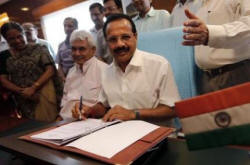|
 India
says private funds will help rail system, but details
unavailable India
says private funds will help rail system, but details
unavailable
 Send a link to a friend
Send a link to a friend
[July 08, 2014]
By Tommy Wilkes
NEW DELHI (Reuters) - Prime
Minister Narendra Modi's new government has nudged up
spending on India's wobbly railways and will seek
private funding for new projects, the rail minister said
without giving details on how he will attract investors.
|
|
 Indian markets reacted negatively to the railways budget presented
on Tuesday, after high expectations that Modi's government would use
its first major economic policy statement to detail widespread
reform. Indian markets reacted negatively to the railways budget presented
on Tuesday, after high expectations that Modi's government would use
its first major economic policy statement to detail widespread
reform.
India's state-owned railway, the world's fourth-largest, has
suffered from years of low investment and populist policies that
have kept fares low. This has turned a once-mighty system into a
slow, badly-congested network that crimps economic growth.
The railway costs the government's public finances around 300
billion rupees ($5 billion) a year in subsidies.
"The bulk of our future projects will be... by the PPP model,"
Railway Minister Sadananda Gowda told India's parliament in his
first budget, referring to public-private partnerships. Gowda's
speech promised to get the railway's finances in order, complete
long-delayed projects and jumpstart ambitious plans for high-speed
rail, but was short on details of how these goals would be met and
how foreign direct investment (FDI) would be attracted.

The government revised up planned spending to 654.45 billion Indian
rupees ($10.95 billion) for the year ending in March 2015, up 1.8
percent from an interim budget made in February by the last
government.
It calculates investment in the network through public-private
partnerships in 2014/15 to total 60.05 billion rupees, more than in
the interim budget, but a fraction of the cash needed to overhaul
the network.
RELIC FROM BRITISH RULE
India's use of a railway budget separate from the national one is a
relic of British rule, when the network was the country's major
industrial asset and a major revenue earner. Finance Minister Arun
Jaitley presents the full federal budget on Thursday.
"There is nothing in this entire budget which tells you how they
will make it attractive for private sector," said Manish R. Sharma,
executive director of capital projects and infrastructure at PwC
India.
[to top of second column] |

"Given that in the past PPP has not taken off in railways...it would
be very important to see how they come up with implementable
mechanisms which the private sector will buy," he said.
Stock investors also expressed doubts about the prospects for PPPs,
with shares in India's railway-related stocks falling after the
speech. Texmaco Rail & Engineering fell 8 percent and was down 20
percent by 0940 GMT while Titagarh Wagons dropped 5 percent.
"Budgeted outlay is looking below expectations as the government is
looking for more private partnerships now than in previous
occasions," said Deven Choksey, managing director at KR Choksey
securities.
Reform of India's railways has long proven politically sensitive.
Successive governments have backed away from modernization,
preferring instead to use the system to provide cheap transport for
voters, and jobs for 1.3 million people.
($1 = 59.7400 Indian Rupees)
(Additional reporting by Malini Menon, Manoj Kumar, Aditya Kalra,
Suvashree Dey Choudhury and Abhishek Vishnoi; Editing by Frank Jack
Daniel and Richard Borsuk)
[© 2014 Thomson Reuters. All rights
reserved.] Copyright
2014 Reuters. All rights reserved. This material may not be
published, broadcast, rewritten or redistributed.
 |